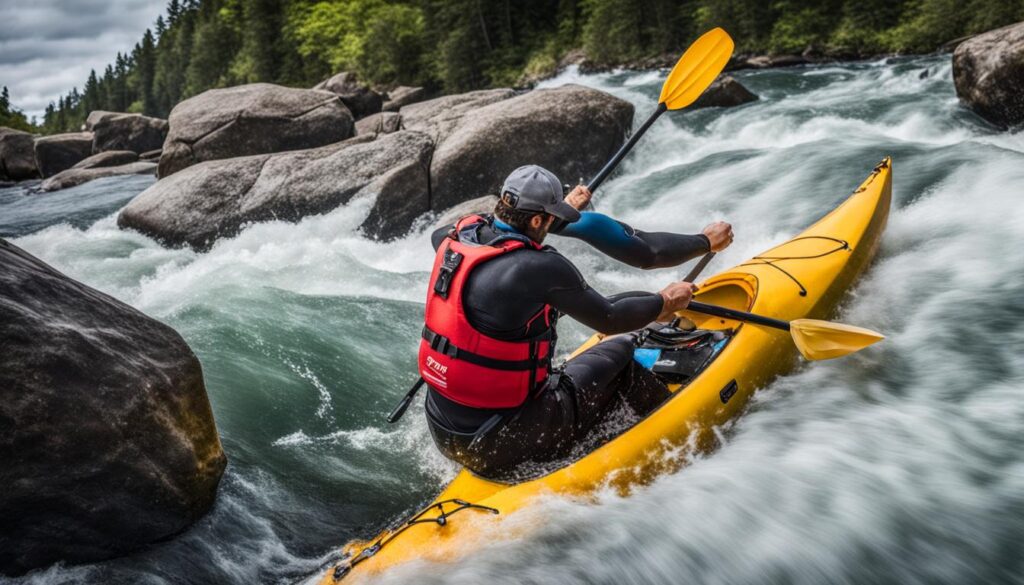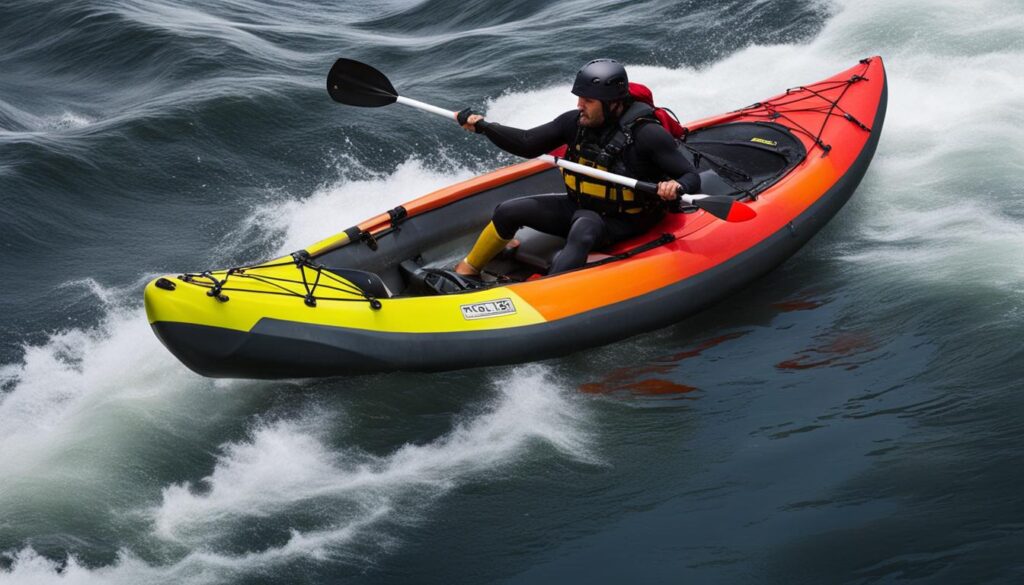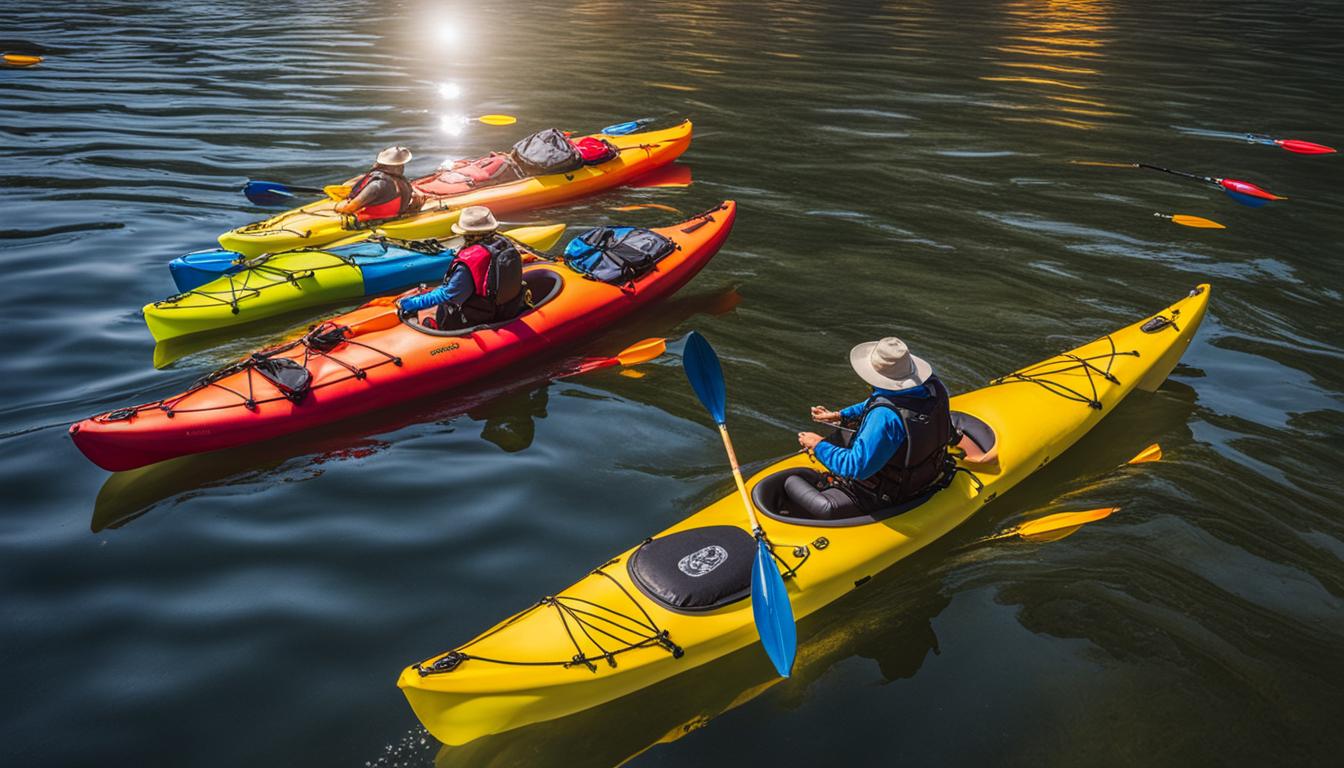When it comes to kayaking, safety should always be your top priority. One essential piece of equipment that every kayaker should have is a Personal Flotation Device, or PFD. A PFD provides buoyancy, helping you stay afloat in the water and giving you peace of mind while you explore the great outdoors.
But how do you know which PFD is right for you? And what factors should you consider when adjusting the buoyancy of your kayak PFD?
In this article, we will explore the ins and outs of PFD buoyancy for kayakers. We’ll discuss the different types of PFDs available, highlight the key differences between standard PFDs and inflatable PFDs, emphasize the importance of sizing and fitting, and provide essential information about PFD features and specifications to consider. By the end, you’ll have a solid understanding of how to choose the right buoyancy aid for your paddling adventures.
Key Takeaways:
- Choosing the right PFD is crucial for your safety while kayaking.
- There are different types of PFDs available, including standard PFDs and inflatable PFDs.
- PFD sizing and fitting are essential for a comfortable and secure fit.
- Buoyancy aids, also known as personal flotation devices, are suitable for recreational paddling activities.
- Regular maintenance and proper care are necessary to ensure optimal PFD performance.
Standard PFDs vs. Inflatable PFDs: Which is Right for You?
When it comes to choosing the right personal flotation device (PFD) for kayaking, you have two main options: standard PFDs and inflatable PFDs. Each type has its own advantages and considerations, so it’s important to understand their differences before making a decision.
Standard PFDs
Standard PFDs, also known as life vests, are the more traditional and widely used option among kayakers. These PFDs provide inherent buoyancy and come in the form of vests. One of the key benefits of standard PFDs is their versatility. They are suitable for various water sports, including kayaking, canoeing, and paddleboarding. Standard PFDs also often feature pockets, providing convenient storage for small items like a whistle or sunscreen. However, some kayakers find standard PFDs to be bulky and hot, especially during warm weather.
Inflatable PFDs
Inflatable PFDs offer a more compact and comfortable alternative to standard PFDs. These PFDs rely on manual or automatic inflation to provide buoyancy when needed. One of the main advantages of inflatable PFDs is their slim design, which allows for greater freedom of movement while paddling. Inflatable PFDs are particularly popular among kayakers engaged in active water sports. However, it’s important to note that inflatable PFDs require regular maintenance, including checking the inflation mechanism and ensuring proper functioning.
Choosing the Right PFD for You
When deciding between standard PFDs and inflatable PFDs, consider your specific needs and preferences. If you prioritize versatility and convenience, a standard PFD might be the better choice for you. On the other hand, if comfort and freedom of movement are important to you, an inflatable PFD could be the right option. Remember to also consider factors such as the water conditions you’ll be kayaking in and any weight restrictions for the PFDs. Ultimately, the most important thing is to choose a PFD that fits properly, is comfortable to wear, and enhances your safety on the water.
| Standard PFDs | Inflatable PFDs | |
|---|---|---|
| Design | Vest-style | Slim and compact |
| Buoyancy | Inherent buoyancy | Manual or automatic inflation |
| Versatility | Suitable for various water sports | Ideal for active water sports |
| Convenience | Pockets for storage | Compact and comfortable |
| Maintenance | Low maintenance | Regular checks and servicing |
The Importance of PFD Sizing and Fitting
Proper PFD sizing and fitting are crucial for ensuring both comfort and safety while kayaking. Whether you’re navigating swift currents or exploring calm waters, a well-fitting PFD is essential to keep you secure in the event of an unexpected capsize or accident.
When it comes to sizing, adults should base their PFD selection on chest size, while weight is the determining factor for children. It’s important to accurately measure the chest circumference and follow the manufacturer’s size recommendations for the best fit. A PFD that is too loose may ride up and interfere with your ability to swim, while one that is too tight can restrict your movement and cause discomfort.
Once you’ve chosen the correct size, it’s crucial to properly adjust the straps to achieve a snug, yet comfortable fit. Make sure all straps are securely fastened and tighten them as necessary. Additionally, you may need to make additional adjustments to customize the fit and ensure the PFD stays securely in place during water activities.
To ensure that your PFD is functioning as intended, it’s recommended to test it in the water before heading out on your kayaking adventure. By doing so, you can ensure that the PFD provides sufficient buoyancy to keep your head above water and that it doesn’t shift or ride up during movement. This simple step can help give you peace of mind and enhance your safety while on the water.

Summary:
- Proper PFD sizing based on chest size for adults and weight for children is essential.
- Adjust straps to achieve a snug and comfortable fit.
- Make additional adjustments to customize the fit for optimal comfort and safety.
- Test your PFD in the water to ensure it provides sufficient buoyancy and stays in place during water activities.
PFD Features and Specifications to Consider
When choosing a personal flotation device (PFD) for kayaking, it’s important to consider the various features and specifications that can enhance performance and safety. Here are some key factors to keep in mind:
1. Buoyancy
The buoyancy of a PFD determines the amount of force required to keep a person’s head and chin above water. Most PFDs provide more flotation than the minimum requirement set by the U.S. Coast Guard, but factors such as body weight and clothing can affect flotation. It’s important to choose a PFD with sufficient buoyancy for your specific needs, whether you’re kayaking in calm waters or facing swift currents.
2. PFD Type
PFDs are classified by the U.S. Coast Guard into different types. Type III PFDs are the most common for kayaking, as they provide a good balance between comfort and safety. Type V PFDs are specialized for specific activities, such as high-impact kayaking, but may require additional training or special care. Understanding the different types and their intended use is important when selecting a PFD.
3. Additional Features
Many PFDs come with additional features designed to improve functionality and safety. These can include pockets for storage, color options for visibility, tabs for attaching accessories, reflective tape for enhanced visibility in low light conditions, and ventilation to keep you cool on hot days. Consider which features are most important to you based on your kayaking needs and preferences.
| Feature | Description |
|---|---|
| Pockets | Provide storage for small items like a whistle or sunscreen. |
| Color Options | Choose bright colors for increased visibility on the water. |
| Tabs | Offer attachment points for accessories like a knife or fishing gear. |
| Reflective Tape | Enhances visibility in low light conditions or during emergencies. |
| Ventilation | Keeps you cool and comfortable during warm weather paddling. |
It’s important to note that regular maintenance is necessary to ensure the optimal performance of your PFD. Check the buoyancy periodically and inspect the PFD for any damage or wear. Clean and dry the PFD according to the manufacturer’s instructions to prevent mold and mildew. By considering these features and properly maintaining your PFD, you can ensure a safe and enjoyable kayaking experience.
Choosing the Right Buoyancy Aid for Paddling
Buoyancy aids are essential for paddlers to ensure safety and peace of mind on the water. When it comes to choosing the right buoyancy aid for your paddling needs, there are a few key considerations to keep in mind.
First and foremost, it’s important to consider the weight of the individual who will be wearing the buoyancy aid. Different buoyancy aids have different buoyancy levels, which are designed to support individuals of varying weights in the water. Ensuring that the buoyancy aid you choose has the appropriate buoyancy for your weight will help keep you afloat and provide the necessary support in case of an emergency.
Additionally, it’s important to consider whether the buoyancy aid allows for any adjustments. Adjustable buoyancy aids can be customized to fit your body shape and size, ensuring a comfortable and secure fit. This is particularly important for activities like kayaking, where movement and range of motion are crucial. Adjustable buoyancy aids can be tightened or loosened as needed, allowing for a personalized fit that will keep you safe and comfortable throughout your paddling adventures.
“Choosing a buoyancy aid that is specifically designed for paddling activities is essential for comfort and effectiveness.”
When selecting a buoyancy aid, it’s also important to consider the specific activities you will be engaging in. Certain buoyancy aids are designed with particular water sports in mind, such as kayaking or canoeing. These buoyancy aids often feature additional pockets and storage options, allowing you to carry essential gear and equipment with ease. Choosing a buoyancy aid that is specifically designed for paddling activities will ensure that it meets your needs and provides the necessary support and functionality.
| Buoyancy Aid Type | Buoyancy Level | Adjustable | Recommended Activities |
|---|---|---|---|
| Standard Buoyancy Aid | Medium | No | Recreational kayaking, canoeing |
| Touring Buoyancy Aid | High | Yes | Touring, sea kayaking |
| Whitewater Buoyancy Aid | Low | Yes | Whitewater paddling |
| SUP Buoyancy Aid | Medium | Yes | Stand-up paddleboarding |
Ultimately, choosing the right buoyancy aid is a personal decision that depends on your specific needs and preferences. It’s important to take the time to research and try on different buoyancy aids to find the one that feels comfortable and secure for you. Remember, safety should always be the top priority when out on the water, and a buoyancy aid is an essential tool to help ensure a safe and enjoyable paddling experience.
Buoyancy Aids vs. Life Jackets: Understanding the Difference
When it comes to personal flotation devices (PFDs), there are two main types to consider: buoyancy aids and life jackets. While both serve the purpose of keeping individuals afloat in the water, there are some key differences between the two.
Buoyancy aids are designed to provide buoyancy while allowing the wearer to move and swim freely. They are typically worn as jackets and are suitable for general use and recreational paddling. Buoyancy aids rely on the wearer’s ability to actively stay afloat, making them ideal for confident swimmers.
On the other hand, life jackets use inflatable chambers to provide buoyancy. They are specifically designed for situations where passive flotation is required, such as for non-swimmers or in emergency situations where unconsciousness may occur. Life jackets offer a higher level of buoyancy and are recommended for children and water activities with a greater risk of submersion.
When choosing between a buoyancy aid and a life jacket, it’s important to consider your swimming ability, the specific water activity, and the level of flotation required. Always check the buoyancy of your PFD before kayaking, especially in swift currents or challenging conditions, to ensure it meets the necessary safety standards.

Table: A Comparison of Buoyancy Aids and Life Jackets
| Criteria | Buoyancy Aids | Life Jackets |
|---|---|---|
| Intended Use | General use and recreational paddling | Non-swimmers and emergency situations |
| Flotation Type | Relies on wearer’s ability to actively stay afloat | Uses inflatable chambers for passive flotation |
| Buoyancy Level | Lower, suitable for confident swimmers | Higher, suitable for non-swimmers and emergency situations |
| Recommended for | Recreational paddling and confident swimmers | Non-swimmers, children, and high-risk water activities |
Choosing the Right Buoyancy Aid for Paddling Activities
When it comes to paddling activities, choosing the right buoyancy aid is crucial to ensure your safety and comfort on the water. Each type of activity requires a specific type of buoyancy aid that caters to its unique demands and challenges.
For recreational leisure paddling, a standard buoyancy aid is suitable. These buoyancy aids provide the necessary safety without any extra features, allowing you to enjoy a peaceful day on the water. They are designed to provide optimal buoyancy while ensuring comfort throughout your paddling adventure.
For touring and sea kayaking, buoyancy aids that come with pockets and higher-quality foam are ideal. These buoyancy aids not only provide the necessary flotation but also offer enhanced comfort and storage options for your equipment. Whether you’re exploring serene coastlines or embarking on long-distance journeys, these buoyancy aids are designed to meet your needs.
Whitewater paddling requires a different type of buoyancy aid with lower volume. This design prevents the buoyancy aid from catching on branches or rocks during challenging whitewater runs. It’s important to choose a buoyancy aid specifically designed for whitewater paddling to ensure maximum safety and freedom of movement.
Kayak PFD Buoyancy for High-Impact Kayaking
For those engaging in high-impact kayaking activities, buoyancy aids with additional features and higher buoyancy levels are recommended. These buoyancy aids are designed to provide extra protection and flotation during fast-paced, high-energy kayaking. They offer the peace of mind and security needed to fully enjoy the excitement and adventure of high-impact kayaking.
Understanding PFD buoyancy levels is essential when selecting a buoyancy aid for high-impact kayaking. Higher buoyancy levels ensure you stay afloat and maintain proper body position, even in turbulent water conditions. This allows you to focus on maneuvering your kayak and navigating through challenging rapids without worrying about your safety.
By choosing the right buoyancy aid for your paddling activity, you can ensure a safe and enjoyable experience on the water. Consider the specific demands of your activity, the features that matter most to you, and the appropriate buoyancy levels to find the perfect buoyancy aid that meets your needs. Remember, safety should always be your top priority when engaging in any paddling activity!
Conclusion
Understanding PFD buoyancy is crucial for kayakers to ensure their safety and enhance their paddling experience. By selecting the right type of PFD and considering factors like standard vs. inflatable, sizing, and fitting, you can make the most of your time on the water.
Maintaining PFD floatation is essential for optimal performance. Regularly checking the buoyancy of your kayak PFD and ensuring it stays clean and dry will help it function effectively when you need it most. This simple maintenance routine will give you peace of mind and keep you safe on your kayaking adventures.
Remember, buoyancy aids are recommended for recreational paddling, while life jackets are best for non-swimmers or situations requiring passive flotation. Whichever option you choose, wearing a PFD is a must for every kayaker. So, make sure you take the necessary steps to maintain your kayak PFD’s floatation and enjoy every moment on the water with confidence!
FAQ
What is the purpose of a personal flotation device (PFD)?
A PFD provides buoyancy to help kayakers stay afloat in the water.
What are the different types of PFDs approved by the U.S. Coast Guard?
The main options for kayakers are standard PFDs, inflatable PFDs, and hybrid PFDs.
What is the difference between standard PFDs and inflatable PFDs?
Standard PFDs provide inherent buoyancy and are commonly used, while inflatable PFDs are more compact and comfortable to wear.
How important is proper PFD sizing and fitting?
Proper PFD sizing and fitting are crucial for comfort and safety while kayaking.
What are some important features to consider when choosing a PFD?
Pockets, color, tabs, reflective tape, and ventilation are some common features to consider.
What is the difference between buoyancy aids and life jackets?
Buoyancy aids rely on the wearer’s ability to move and swim, while life jackets use inflatable chambers to provide buoyancy.
How do I choose the right buoyancy aid for different paddling activities?
The specific type of buoyancy aid to choose depends on the paddling activity, such as recreational leisure paddling, touring and sea kayaking, whitewater paddling, or stand-up paddleboarding.





